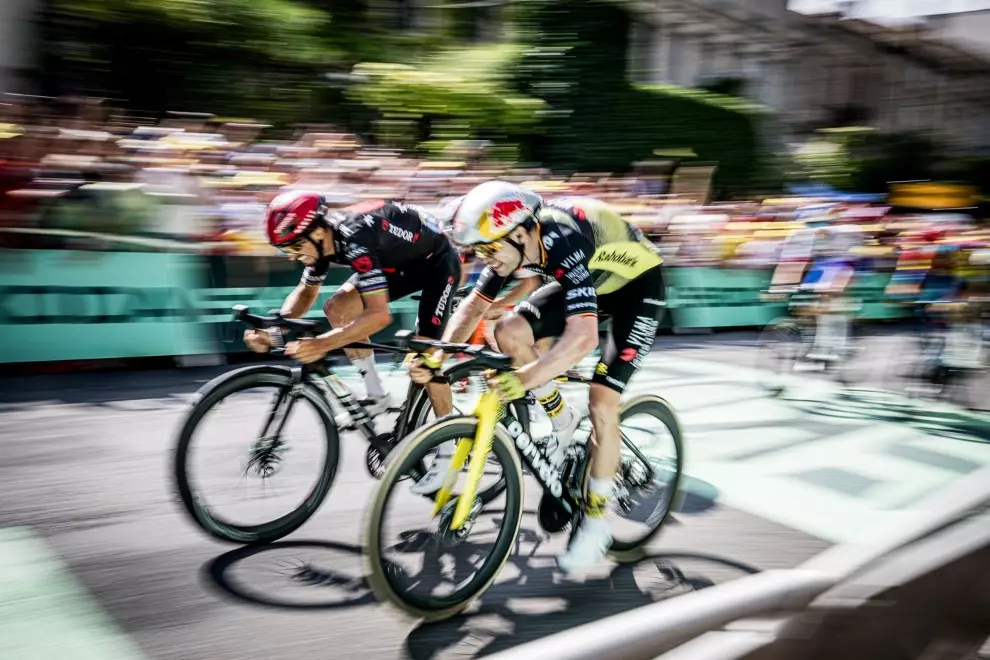There’s already a metric for speed, another for elevation, and even one for efficiency, but where’s the recognition for the ride where your legs felt like jelly, your lungs staged a protest, and your soul left your body somewhere on the last climb? Strava has overlooked the most sacred cycling experience—absolute, soul-crushing misery.
So, if you are a Strava executive, lend me your ear and let’s talk about innovations. It’s time to have a suffering score on our favourite social. After all, if we’re gonna suffer, we might as well get credit for it and brag about it.
What would Strava’s suffering score be?
A revolutionary new Strava metric that doesn’t care how fast you are—it only cares about how awful you felt doing it. It would be ideal for those newbies who can barely breathe at the top of a climb while seeing others climb it in the blink of an eye. It will be the perfect hook for those riders who can’t afford to beat the local segment record, but they can surely suffer trying to get there. Isn’t that the pillar of every cyclist’s motivation?
Think of it as a pain scale for your ride, finally giving you bragging rights for surviving the most absurdly miserable conditions. While traditional metrics like heart rate zones and power output focus on performance, the Suffering Score would focus entirely on raw, unfiltered psychological torture. Now you’re getting what cycling is all about. It would be the ultimate testament to mental fortitude, endurance, and sheer refusal to quit, no matter how badly the ride was going.
How would it be calculated?
This is the biggest question. How can one evaluate psychological trauma in an app? While it would be fun to have a real psychologist listening to your moans every single time you get on your bike, it’s not the most cost-efficient method to get there. So, instead, let’s focus on the good old algorithms.
Strava’s algorithm would need to factor in the many ways a cyclist can completely destroy their body, soul, and spirit. Elevation gain would be a crucial element because nothing screams “suffering” quite like grinding up a climb so steep that you start contemplating whether your grandma’s knitting hobby is not more to your liking. The longer you stare at your GPS in despair as the gradient climbs to double digits, the higher your suffering score. Bonus points if you’ve ever gotten off and pushed your bike while pretending to “admire the scenery” or “have a quick stop to take a picture of the landscape.”

Temperature would play a major role because suffering is best experienced in extreme weather. If your water bottle turns into a lava lamp under the scorching sun or freezes into an unusable ice brick mid-ride, Strava should acknowledge your suffering. Extra kudos for the riders who bravely venture out into sub-zero temperatures, only to realise too late that their expression will change only after spring pops in. Wind speed would be another essential metric. Every cyclist knows that tailwinds are a myth, while headwinds are a cruel reality designed to break your will to live. Damn you, Obama. If you’ve ever felt like you were pedalling through molasses while staying in exactly the same place, your suffering score would skyrocket. Bonus points if the wind also carried debris that slapped you across the face or if a passing truck created a vortex that sent you into the next town over.
But while nature is a cruel mistress, it’s not the only one that can drag you back during your ride. Mechanical issues can play a significant role in calculating your overall suffering score. Snapped chains, three punctures in a row or mysteriously losing all but one gear would significantly boost your misery rating. Extra suffering points if you had to MacGyver a repair with nothing but zip ties and a lot of prayers to your god of choice. But the biggest bonus would be for those repairing their bike while trying to run away from a thunderstorm.
The biggest points, however, will be allocated for your huffs and puffs, trying to beat yourself on a ride. This can be done by connecting Strava to your phone’s microphone and listening to key phrases, most of which I’m not really allowed to type out here. So, let’s just say some colourful phrases that usually wish peace and harmony to all.
KOMs and PRs make their way to the suffering leaderboard
KOMs and PRs would become secondary to the true mark of a cyclist’s dedication: just how much they managed to physically and emotionally destroy themselves in one ride. Riders wouldn’t be chasing speed anymore—they’d be hunting suffering points like masochistic Pokémon trainers.
At the top of this glorious leaderboard would be prestigious new titles. First, there’s the Everest Sufferer, reserved for those who decided climbing 8,848 meters in one ride was a fun idea, only to realise halfway through that they had made a terrible mistake. Then we have the Bonk King or Queen, a special honour bestowed upon those who completely miscalculated their nutrition and ended up seeing Jesus—or at least a talking cheeseburger—on the last stretch of their ride. The Mechanical Menace award would go to the unlucky souls who suffered through multiple catastrophic bike failures but still managed to limp home using sheer force of will, complemented by zip ties and duct tape.
Finally, there will be the Drama King and Queen, which will be awarded to the authors of the most melodramatic activity titles, each under 55 characters. So, no more “Lunch ride” or “Good ride, feeling strong.” Strava will be all about “Destroyed legs, wishing to die” and “Spat my lungs out on this climb.”
The impact on Strava culture
Are you ready for a total redo of the Strava culture? Ride reports would no longer be about power output or personal bests, but rather about who suffered the most. Instead of being competitive about speed, group rides would turn into suffering contests, with riders intentionally choosing the most brutal routes to earn higher scores. The more hills, the worse the weather, and the fewer snacks brought along, the better. Stopping at a café? That’s for quitters. Real riders push through the hunger-induced hallucinations and the existential dread of another climb just to boost their Suffering Score.
New Strava challenges would emerge, focusing not on performance but on endurance through sheer misery. Riders would find themselves attempting new challenges such as Cry at Least Once on a Ride, which would encourage pushing past the limits of exhaustion, or Maximum Bonk Attempt, where participants would ride as far as possible without proper nutrition just to see how delirious they could get before crawling into a café. There would also be the esteemed Broken Spirit Badge, awarded only to those who seriously contemplated throwing their bike into a ditch mid-ride but heroically continued onward,
As with any Strava feature, this would lead to inevitable flexing. Cyclists would soon be comparing suffering scores, scoffing at rides that didn’t meet their standards. Comments like, “Only got a Suffering Score of 80? Must’ve been an easy ride,” would become the new form of competitive banter. Group rides would no longer be planned for scenic enjoyment but for sheer brutality, with one member always suggesting, “What if we add another 1,000 meters of climbing?” just to see who breaks first.
But it wouldn’t all be bad. In the pursuit of suffering, riders would inadvertently become stronger. As they pushed themselves to rack up more suffering points, their endurance, mental toughness, and overall fitness would improve. Those who once shied away from hills would now actively seek them out, and riders who used to carry energy bars like a safety blanket would learn to survive on sheer determination (and perhaps a stolen sugar packet from a roadside café). The Suffering Score might start as a joke, but in the end, it would create some of the toughest cyclists the world has ever seen.
The most hilarious part is that pro cyclists will no longer ruin it for us mere mortals. I mean, they can never suffer as we do anywhere.
The suffering score will be the new gold standard
At the end of the day, cyclists have an undeniable love for suffering. There is something strangely satisfying about waking up at the crack of dawn to ride in freezing rain, torturing ourselves with hill repeats, and stubbornly refusing to call for a pickup even when stranded miles from home. A Suffering Score wouldn’t just be welcomed—it would be obsessively chased. It would become the new Holy Grail of cycling metrics, something riders would take pride in earning.
The real question isn’t whether Strava will ever introduce this feature but rather why it hasn’t happened yet. It perfectly aligns with the cyclist mentality of enduring pain for the sake of personal glory, and it would undoubtedly become the most talked-about feature overnight. So, Strava executives, I’m open to negotiations on the royalties for that idea.
And if you think I’m joking, just survey whether cyclists will enjoy such a feature.




